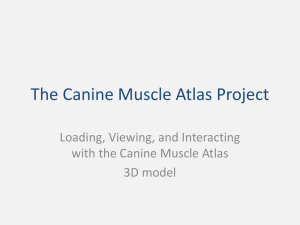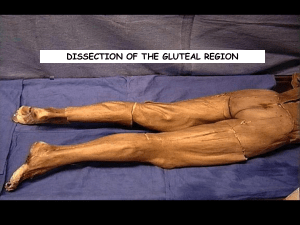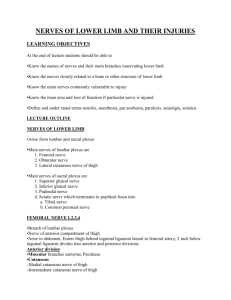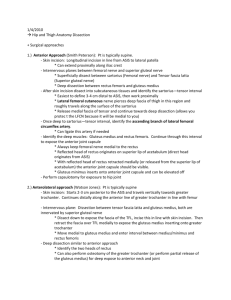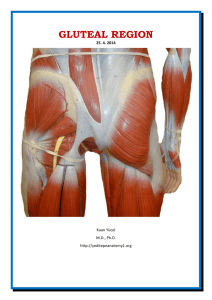Gluteal Region Anatomy: Muscles, Nerves, Vessels
advertisement
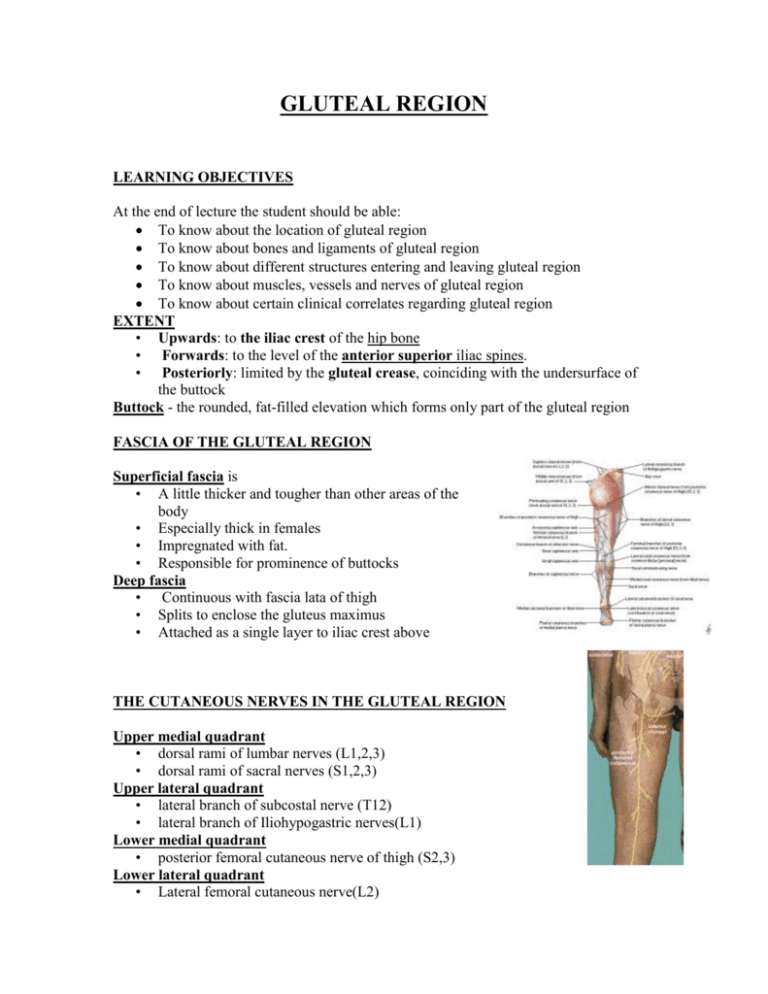
GLUTEAL REGION LEARNING OBJECTIVES At the end of lecture the student should be able: To know about the location of gluteal region To know about bones and ligaments of gluteal region To know about different structures entering and leaving gluteal region To know about muscles, vessels and nerves of gluteal region To know about certain clinical correlates regarding gluteal region EXTENT • Upwards: to the iliac crest of the hip bone • Forwards: to the level of the anterior superior iliac spines. • Posteriorly: limited by the gluteal crease, coinciding with the undersurface of the buttock Buttock - the rounded, fat-filled elevation which forms only part of the gluteal region FASCIA OF THE GLUTEAL REGION Superficial fascia is • A little thicker and tougher than other areas of the body • Especially thick in females • Impregnated with fat. • Responsible for prominence of buttocks Deep fascia • Continuous with fascia lata of thigh • Splits to enclose the gluteus maximus • Attached as a single layer to iliac crest above THE CUTANEOUS NERVES IN THE GLUTEAL REGION Upper medial quadrant • dorsal rami of lumbar nerves (L1,2,3) • dorsal rami of sacral nerves (S1,2,3) Upper lateral quadrant • lateral branch of subcostal nerve (T12) • lateral branch of Iliohypogastric nerves(L1) Lower medial quadrant • posterior femoral cutaneous nerve of thigh (S2,3) Lower lateral quadrant • Lateral femoral cutaneous nerve(L2) BONES OF GLUTEAL REGION • Parts of following bone are present in gluteal region – back of hip bone – upper end of femur – Back of sacrum – Hip joint is the main joint in gluteal region formed between acetabulum of hip bone and head of femur LIGAMENTS OF GLUTEAL REGION Sactotuberous ligament • From back of sacrum to ischial tuberosity Sacrospinous ligament • From back of sacrum to spine of ischium The convert the greater and lesser sciatic notches into foramina of same name FORAMINA OF GLUTEAL REGION Greater sciatic foramen Structures leaving pelvis entering gluteal region are: • Piriformis muscle Structures passing above piriformis • Superior gluteal vessels and nerve Structures passing below the piriformis • sciatic nerve • Posterior cutaneous nerve of thigh • Inferior gluteal vessels and nerves • Nerve to obturator and quadratus femoris • Pudendal nerve • Internal pudendal vessels Lesser sciatic foramen Entrance into perineum from gluteal region Structures passing through it: • Tendon of obturator internus • Internal pudendal vessels • Pudendal nerve • Nerve to obturator internus MUSCLES OF GLUTEAL REGION • Gluteus maximus • Gluteus medius • Gluteus minimus • Tensor fascia lata • Piriformis • Obturator internus • Gemellus superior • Gemellus inferior • Quadratus femoris Gluteus maximus Largest muscle in the body Origin • Outer surface of ilium, sacrum, coccyx Insertion • Iliotibial tract and gluteal tuberosity of femur Action • Extensor and lateral rotator of hip • extensor of knee through iliotibial tract Three bursa are related Between tendon of insertion and greater trochanter Between tendon of insertion and vastus lateralis Bursa overlying ischial tuberosity Gluteus medius Origin • Outer surface of ilium Insertion • Lateral surface of greater trochanter of femur Gluteus minimus Origin • Outer surface of ilium Insertion • Anterior surface of greater trochanter of femur Actions of gluteus medius and minimus • Abductors of hip • During walking, when opposite foot is off the ground, tilt opposite side of pelvis upward, support pelvis during walking Tensor fascia lata • Can be seen on the lateral side of gluteal region Origin • Iliac crest Insertion • Iliotibial tract Action • Assists gluteus maximus in extension of knee Piriformis Passes through greater sciatic foramen Origin in the pelvis • Anterior surface of sacrum Insertion in gluteal region • Ant surface of greater trochanter Nerve supply • S1 S2 Origin of • Gemellus superior from spine of ischium • Obturator internus from Inner surface of obturator membrane • Gemellus inferior from Ischial tuberosity Insertion of • above 3 muscles is on upper border of greater trochanter • quadtratus femoris arise from ischial tuberosity inserted at quadrate tubercle of femur All of the following muscles of gluteal region are LATERAL ROTATOR of hip Piriformis Obturator internus Superior Gamellus Inferior Gamellus Quadratus femoris NERVE SUPPLY OF GLUTEAL MUSCLES • Superior gluteal nerve – Gluteus medius – Gluteus minimus – Tensor fascia lata • Inferior gluteal nerve to gluteus maximus • Nerve to obturator internus • – Obturator internus – Superior Gamellus Nerve to quadratus femoris – Quadratus femoris – Inferior Gemellus NEUROVASCULATURE OF GLUTEAL REGION • The PIRIFORMIS muscle separates the greater sciatic foramen into superior and inferior parts • The branches of nerves and vessels come into the gluteal region either through the superior part or the inferior part VESSELS OF THE GLUTEAL REGION There are three VESSELS i.e. arteries and veins coming into the gluteal region through the greater sciatic foramen: Inferior gluteal Superior gluteal Internal pudendal These vessels are branches and tributaries of the internal iliac artery and vein respectively, which lie inside the pelvis Superior gluteal vessels • Artery is a Branch of internal iliac artery • Vein is a tributary of internal iliac vein • Passes through greater sciatic foramen above piriformis • Runs between gluteus medius and minimus Inferior gluteal vessels • Artery is branch of internal iliac artery • vein is a tributary of internal iliac vein • Pass through greater sciatic foramen below piriformis • Run between gluteus maximus and medius Internal pudendal vessels • Very short course in gluteal region • Enters through greater sciatic foramen • Leave through lesser sciatic foramen and enter perineum Trochanteric anastomosis: • Main source of blood supply to head of femur • Lie near trochanteric fossa • Arteries taking part are: – Superior gluteal(descending branch) – Medial circumflex femoral(ascending branch) – Lateral circumflex femoral(ascending branch ) – Inferior gluteal Cruciate anastomosis: • Lie at the level of middle of lesser trochanter of femur • Arteries taking part are: – Medial circumflex femoral(transverse branch) – Lateral circumflex femoral(transverse branch ) – Inferior gluteal(descending branch) – First perforating (ascending) NERVES OF THE GLUTEAL REGION • Branches of the lumbosacral plexus • Enter gluteal region from pelvis through greater sciatic foramen Passing above the piriformis • Superior gluteal Passing below piriformis • Inferior gluteal • Sciatic • Posterior femoral cutaneous • Pudendal • Nerve to quadratus femoris • Nerve to obturator internus Superior gluteal nerve • Branch of sacral plexus • Enter gluteal region above piriformis • Runs between gluteus medius and minimus Muscles innervated: • Gluteus medius • Gluteus minimus • Tensor fascia lata Inferior gluteal nerve • Branch of sacral plexus • Enter gluteal region below piriformis • Runs between gluteus maximus and medius Muscle innervated • Gluteus maximus Sciatic nerve • Largest nerve of body • Branch of sacral plexus • Consists of tibial and common peroneal nerve bound together • Enters gluteal region below piriformis • Leaves gluteal region by passing beneath the long head of bicep femoris ,enters in posterior compartment of thigh Relations of sciatic nerve Anterior relation – root of ischial spine – Superior Gemellus – Obturator internus – Inferior Gemellus – Quadratus femoris – Back of adductor magnus Posterior relation – Posterior cutaneous nerve of thigh – Gluteus maximus Posterior cutaneous nerve of thigh • Branch of sacral plexus • Enters gluteal region below piriformis Relations • Anterior: sciatic nerve • Posterior: deep fascia Branches of posterior cutaneous nerve of thigh • Lower medial quadrant of gluteal area • Perineal branches to skin of back of scrotum/labium majus • Cutaneous supply to back of thigh and popliteal fossa Pudendal nerve and nerve to obturator internus • Branches of sacral plexus • Short course in gluteal region • Enter through greater sciatic foramen • Leave gluteal region through lesser sciatic foramen • Crosse ischial spine • Pudendal nerve supplies perineum • Nerve to obturator internus – obturator internus – superior Gemellus Nerve to quadratus femoris • Branch of sacral plexus • Enters gluteal region below piriformis Muscles innervated – – Quadratus femoris Inferior Gemellus CLINICAL CORRELATES Gluteal maximus bursitis • Also known as trochanteric bursitis • Inflammation of bursa • Friction or trauma to bursa • Common in athletes • Extremely painful WEAKNESS OF GLUTEUS MEDIUS AND MINIMUS Causes • Inferior gluteal nerve damage • Intrinsic weakness of muscle Symptoms • Inability to lift pelvis while walking • Waddling gait Trendelenburg test (hip) • Test for pathology of hip joint • Drooping of pelvis on one side when ipsilateral foot is lifted off the ground • May be present in other conditions: • Pain (e.g. due to osteoarthritis) • Short femoral neck • Medial migration of femoral head • Neuropathy SCIATIC NERVE AND INTRAMUSCULAR INJECTION • Intramuscualr injections are usually given in gluteus maximus • Sciatic nerve passes midway between greater trochanter and ischial tuberosity • To avoid injury to sciatic nerve, injection should be given in upper outer quadrant GLUTEAL ABCESS • Wrong techniques and bad practices while giving intragluteal injections can lead to gluteal abscess PIRIFORMIS SYNDROME • certain leg positions pull the piriformis up against the sciatic nerve causing buttock pain & radiating leg pain XXXXXXXXXXXXXXXXXXXXXXXXXXXXXXXXXXXXXXXXXXXXXXXXX



